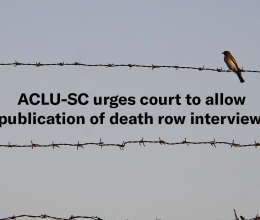
March 8, 2013. Charleston Post & Courier. By Andrew Knapp. Men in green cargo pants and helmets rappel from a roof and point rifles into a hideout. A metal canister bounds into a room and explodes, deafening anyone inside. Armored vehicles speed to a scene, and robots probe a possible bomb.
“It’s always an adrenaline-getter,” says Cpl. Dan Kelling, his gloved hands grasping his rifle. “It’s dangerous, but it’s also exciting at the same time.”
Captured in a YouTube video, the action might conjure up scenes from military films “The Hurt Locker” or “Zero Dark Thirty,” but it instead portrays the Beaufort County Sheriff’s Office SWAT team. It includes tactics and equipment that Sheriff P.J. Tanner, who formed the team in 1986, said are necessary to deal with domestic terrorists and criminals with high-powered weaponry.
Tanner continues to search for methods used more commonly in the battlefield to expand the unit’s capabilities. He’s considering drone aircraft.
But for the American Civil Liberties Union, such military-style approaches “encourage overly aggressive policing — too often with devastating consequences” and constitutional and privacy violations, its website said this week. The ACLU filed Freedom of Information Act requests with Tanner’s agency, as well as the law departments of York and Horry counties, seeking data on military-style tactics.
As a paramilitary organization that receives federal funding to respond to terrorism in the Lowcountry, Tanner said his office makes no apologies for the show of force when his community is in danger. The sheriff said he didn’t “know what they’re talking about” when critics say the approach might heighten the threat of injury.
“If they want to use ‘military-style’ as a tag, I don’t see a downside to that,” Tanner said. “But they’re just tools of our trade. They help us accomplish our two main goals of public safety and officer safety.”
Federal funding
The ACLU has queried agencies in 23 states, including the three departments in South Carolina. Among other topics, the 255 requests seek information on the number of SWAT team deployments and injuries suffered as a result, their funding sources and their use of drones.
Remote-control aircraft have been the source of some notoriety in recent years. They garnered criticism in New York City after the police there announced that they were considering the surveillance method.
On a more extreme scale, federal lawmakers have made a stand — literally — asking current administration officials to clarify whether they would use drones to deliver strikes on American citizens on American soil. Sen. Rand Paul, R-Kentucky, spoke for 13 hours on the topic this week during his filibuster of the president’s nominee for CIA director.
Closer to home, Chief Greg Mullen of the Charleston Police Department spoke of his plans in 2008 to seek funding for unmanned helicopters that could fly over the city in search of suspects or missing people, to survey storm damage or to scout out a house during a standoff.
But the agency didn’t get the $56,000 in federal grant money that it needed to purchase a drone from Daniel Island manufacturer Rotomotion. The business has contracted with the Army and NATO. Most recently, one of its helicopters surveyed damage to a Japanese nuclear plant after a tsunami ravaged it.
Mullen said he has no immediate plans to revive a request for funding. If a drone were put into service, he said, the police would seek input from the community to draft a policy for its use.
“There’s lots of controversy over it right now,” he said, “but it has a place in law enforcement.”
Victoria Middleton, executive director of the ACLU of South Carolina, said the investigation intends to reveal how federal money has militarized police forces. She said $34 billion in federal grants awarded to departments nationwide has been used to buy equipment used in high-risk searches and drug raids.
She said the Richland County Sheriff’s Office might be added to the list of targeted South Carolina agencies. Its SWAT team employs a tank-like personnel vehicle called “The Peacemaker” that’s mounted with an automatic .50-caliber turret gun.
“What effect are these federal funds having on normal searches that would have been routine in the past?” Middleton said. “When you militarize these agencies, are you ramping up those searches?”
‘Far-fetched’
In York County, Sheriff Bruce Bryant said the ACLU’s contention that the tactics could run roughshod over civil liberties, especially in poor neighborhoods, is “comical” and “far-fetched.” Bryant said that his agency acquired surplus military gas masks and riot gear and that he would love a drone to find “that Alzheimer’s patient lost in the woods.”
“But we won’t be launching airstrikes, and we don’t have warehouses of WMDs,” Bryant said. “I’d be glad to open the door and let them come look.”
Most often, controversy sparked by departments’ military-style tactics entails tragedy. In September, Mount Pleasant SWAT team members used high-powered rifles to fatally shoot 60-year-old Richard Cathcart after they said he pointed a pistol at them. Friends of the retiree criticized what they called an over-the-top response to a domestic dispute between Cathcart and his wife.
Tanner, the Beaufort sheriff, said his SWAT team members undergo 16 hours of training monthly so that they’re more versed in handling volatile situations than other patrol officers.
He said a “vast majority” of his 250 employees have served in the military. His group also is accredited, a requirement of the FBI if it is to have the high-powered equipment.
“I want them scared and prepared for the worse,” Tanner said of the SWAT team members. “But they’re not overzealous in what they do. That’s why we train them.”
The idea of drones, he said, is still in the research and development phase.






